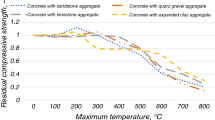Abstract
This paper reports the investigation of the properties of Lightweight Concrete (LWC) made from Portland cement and diatomite aggregate. The chemical and physical properties of diatomite and the mechanical properties of LWC with regard to the effects of calcined temperature and gradation were studied. The uncalcined diatomite was crushed and calcined at 400, 600, and 800°C for 4 hours and used as lightweight aggregate. A constant Water to Cement ratio (W/C) of 2.0 and Aggregate to Cement ratio (A/C) of 1.6 were used for all mixes. The 28-day compressive strength of LWC of 6.4–11.9 MPa, porosity and water absorption of 34.0–49.4%, modulus of elasticity of 2.0–4.3 GPa, thermal conductivity of 0.166–0.192 W/mK, and unit weight of 1170–1300 kg/m3 were obtained. The results indicated that the strength of concrete increased when the calcined temperature of diatomite and the amount of small-size aggregate were increased. The increase in temperature ridded the burnable elements and improved the properties of diatomite. The small-size aggregate produced good matrix-aggregate bonding and enhanced the strength of concrete. The calcined diatomite could, therefore, be used as good aggregate in making lightweight concrete.
Similar content being viewed by others
References
ACI 318M-95 (2000). Building code requirements for structural concrete, ACI Manual of Concrete Practice, Part 3.
ASTM C109 (2002). Standard test method of compressive strength of hydrualic cement mortars (using 2-in. or [50 mm] cube speciments), Annual Book of ASTM Standard, Vol. 04.01.
ASTM C138 (2009). Standard test of method for unit weight of mortar, Annual Book of ASTM Standard, Vol. 04.01.
ASTM C330-89 (1989). Specification for lightweight aggregates for structural concrete, Annual Book of ASTM Standard, Vol. 04.02.
ASTM C331-10 (2010). Standard specification for lightweight aggregates for concrete masonry units, Annual Book of ASTM Standard, Vol. 04.02.
ASTM C39 (2001). Standard test method for compressive strength of cylindrical concrete specimens, Annual Book of ASTM Standard, Vol. 04.02.
ASTM C469 (2002). Standard test method for static modulus of elasticity and poisson’s ratio of concrete in compression, Annual Book of ASTM Standard, Vol. 02.01.
ASTM C642 (2006). Standard test method for density, absorption, and voids in hardened concrete, Annual Book of ASTM Standard, Vol. 04.02.
ASTM D5930 (2009). Standard test method for thermal conductivity of plastics by means of a transient line-source technique, Annual Book of ASTM Standard, Vol. 04.01.
Baronio, G. and Binda, L. (1997). “Study of the pozzolanicity of some bricks and clays.” Construction and Building Materials, Vol. 11, No. 1, pp. 41–46.
Chandra, S. B. L. (2002). Lightweight aggregate concrete: Sciene, technology and application, William Andrew Publishing Norwich, New York, USA.
Charles, C., Diane, H., and McGeary, D. (2007). Physical geology, Eleventh Edition, McGraw-Hill Punlish New York, USA.
Chindaprasirt, P. (1980). Influence of load history on the properties of concrete, PhD Thesis, The University of New South Wales Australia.
Chindaprasirt, P. and Rukzon, S. (2008). “Strength, porosity and corrosion resistance of ternary blend Portland cement, rice husk ash and fly ash mortar.” Construction and Building Materials, Vol. 22, No. 8, pp. 1601–1606.
De Rojas, M. I. S., Rivera, J., and Friìas, M. (1999). “Influence of the microsilica state on pozzolanic reaction rate.” Cement and Concrete Research, Vol. 29, No. 6, pp. 945–949.
Husem, M. (2003). “The effects of bond strengths between lightweight and ordinary aggregate-mortar, aggregate-cement paste on the mechanical properties of concrete.” Materials Science and Engineering: A, Vol. 363, Nos. 1–2, pp. 152–158.
Jo, B. W., Park, S. K., and Park, J. B. (2007). “Properties of concrete made with alkali-activated fly Ash Lightweight Aggregate (AFLA).” Cement and Concrete Composites, Vol. 29, No. 2, pp. 128–135.
Kroehong, W., Sinsiri, T., Jaturapitakkul, C., and Chindaprasirt, P. (2011). “Effect of palm oil fuel ash fineness on the microstructure of blended cement paste.” Construction and Building Materials, Vol. 25, No. 11, pp. 4095–4104.
Kung, L.-S., Su, M.-Q., Shi, X.-S., and Li, Y.-X. (1980). “Research on several physico-mechanical properties of lightweight aggregate concrete.” International Journal of Lightweight Concrete, Vol. 2, No. 4, pp. 185–191.
Malhotra, V. M. (2002). “Introduction: sustainable development and concrete technology.” Concrete International, Vol. 24, No. 7, pp. 22.
Owen, R. B. and Utha-aroom, C. (1999). “Diatomaceous sedimentation in the Tertiary Lampang Basin, Northern Thailand.” Journal of Paleolimnology, Vol. 22, No. 1, pp. 81–95.
Pimraksa, K. and Chindaprasirt, P. (2009). “Lightweight bricks made of diatomaceous earth, lime and gypsum.” Ceramics International, Vol. 35, No. 1, pp. 471–478.
Pimraksa, K., Chindaprasirt, P., Rungchet, A., Sagoe-Crentsil, K., and Sato, T. (2011). “Lightweight geopolymer made of highly porous siliceous materials with various Na2O/Al2O3 and SiO2/Al2O3 ratios.” Materials Science and Engineering: A, Vol. 528, No. 21, pp. 6616–6623.
Rukzon, S. and Chindaprasirt, P. (2008). “Mathematical model of strength and porosity of ternary blend Portland rice husk ash and fly ash cement mortar.” Computers and Concrete, Vol. 5, No. 1, pp. 75–88.
Thokchom, S., Ghosh, P., and Ghosh, S. (2009). “Effect of water absorption, porosity and sorptivity on durability of geopolymer mortars.” ARPN Journal of Engineering and Applied Sciences, Vol. 4, No. 7, pp. 28–32.
Unal, O., Uygunğlu, T., and Yildiz, A. (2007). “Investigation of properties of low-strength lightweight concrete for thermal insulation.” Building and Environment, Vol. 42, No. 2, pp. 584–590.
Uysal, H., Demirboğa, R., Šahin, R., and Gül, R. (2004). “The effects of different cement dosages, slumps, and pumice aggregate ratios on the thermal conductivity and density of concrete.” Cement and Concrete Research, Vol. 34, No. 5, pp. 845–848.
Ylmaz, B. and Ediz, N. (2008). “The use of raw and calcined diatomite in cement production.” Cement and Concrete Composites, Vol. 30, No. 3, pp. 202–211.
Zuhua, Z., **ao, Y., Huajun Z., and Yue, C. (2009). “Role of water in the synthesis of calcined kaolin-based geopolymer.” Applied Clay Science, Vol. 43, No. 2, pp. 218–223.
Author information
Authors and Affiliations
Corresponding author
Rights and permissions
About this article
Cite this article
Posi, P., Lertnimoolchai, S., Sata, V. et al. Investigation of properties of lightweight concrete with calcined diatomite aggregate. KSCE J Civ Eng 18, 1429–1435 (2014). https://doi.org/10.1007/s12205-014-0637-5
Received:
Accepted:
Published:
Issue Date:
DOI: https://doi.org/10.1007/s12205-014-0637-5



